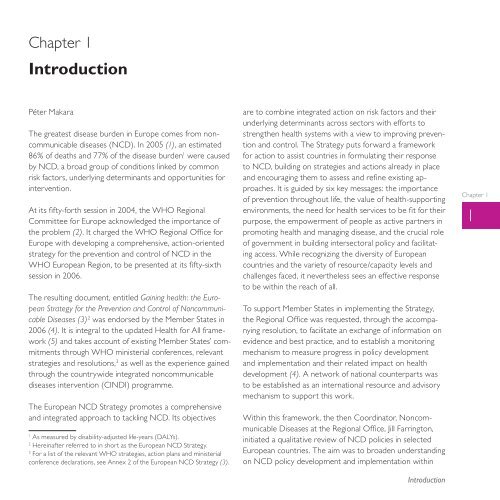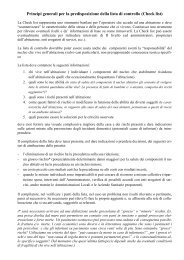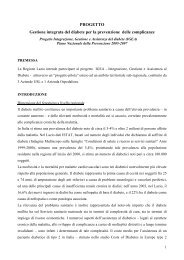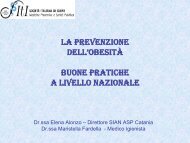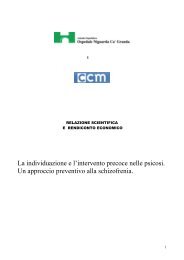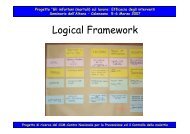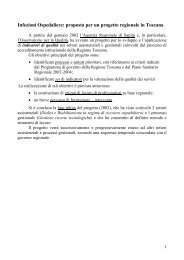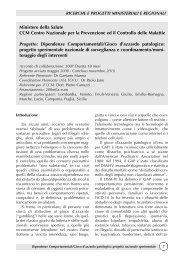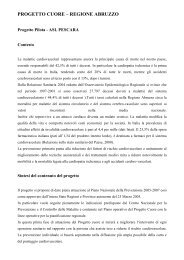Gaining health : analysis of policy development in European ...
Gaining health : analysis of policy development in European ...
Gaining health : analysis of policy development in European ...
You also want an ePaper? Increase the reach of your titles
YUMPU automatically turns print PDFs into web optimized ePapers that Google loves.
Chapter 1<br />
Introduction<br />
Péter Makara<br />
The greatest disease burden <strong>in</strong> Europe comes from noncommunicable<br />
diseases (NCD). In 2005 (1), an estimated<br />
86% <strong>of</strong> deaths and 77% <strong>of</strong> the disease burden 1 were caused<br />
by NCD, a broad group <strong>of</strong> conditions l<strong>in</strong>ked by common<br />
risk factors, underly<strong>in</strong>g determ<strong>in</strong>ants and opportunities for<br />
<strong>in</strong>tervention.<br />
At its fifty-forth session <strong>in</strong> 2004, the WHO Regional<br />
Committee for Europe acknowledged the importance <strong>of</strong><br />
the problem (2). It charged the WHO Regional Office for<br />
Europe with develop<strong>in</strong>g a comprehensive, action-oriented<br />
strategy for the prevention and control <strong>of</strong> NCD <strong>in</strong> the<br />
WHO <strong>European</strong> Region, to be presented at its fifty-sixth<br />
session <strong>in</strong> 2006.<br />
The result<strong>in</strong>g document, entitled <strong>Ga<strong>in</strong><strong>in</strong>g</strong> <strong>health</strong>: the <strong>European</strong><br />
Strategy for the Prevention and Control <strong>of</strong> Noncommunicable<br />
Diseases (3) 2 was endorsed by the Member States <strong>in</strong><br />
2006 (4). It is <strong>in</strong>tegral to the updated Health for All framework<br />
(5) and takes account <strong>of</strong> exist<strong>in</strong>g Member States’ commitments<br />
through WHO m<strong>in</strong>isterial conferences, relevant<br />
strategies and resolutions, 3 as well as the experience ga<strong>in</strong>ed<br />
through the countrywide <strong>in</strong>tegrated noncommunicable<br />
diseases <strong>in</strong>tervention (CINDI) programme.<br />
The <strong>European</strong> NCD Strategy promotes a comprehensive<br />
and <strong>in</strong>tegrated approach to tackl<strong>in</strong>g NCD. Its objectives<br />
1<br />
As measured by disability-adjusted life-years (DALYs).<br />
2<br />
Here<strong>in</strong>after referred to <strong>in</strong> short as the <strong>European</strong> NCD Strategy.<br />
3<br />
For a list <strong>of</strong> the relevant WHO strategies, action plans and m<strong>in</strong>isterial<br />
conference declarations, see Annex 2 <strong>of</strong> the <strong>European</strong> NCD Strategy (3).<br />
are to comb<strong>in</strong>e <strong>in</strong>tegrated action on risk factors and their<br />
underly<strong>in</strong>g determ<strong>in</strong>ants across sectors with efforts to<br />
strengthen <strong>health</strong> systems with a view to improv<strong>in</strong>g prevention<br />
and control. The Strategy puts forward a framework<br />
for action to assist countries <strong>in</strong> formulat<strong>in</strong>g their response<br />
to NCD, build<strong>in</strong>g on strategies and actions already <strong>in</strong> place<br />
and encourag<strong>in</strong>g them to assess and ref<strong>in</strong>e exist<strong>in</strong>g approaches.<br />
It is guided by six key messages: the importance<br />
<strong>of</strong> prevention throughout life, the value <strong>of</strong> <strong>health</strong>-support<strong>in</strong>g<br />
environments, the need for <strong>health</strong> services to be fit for their<br />
purpose, the empowerment <strong>of</strong> people as active partners <strong>in</strong><br />
promot<strong>in</strong>g <strong>health</strong> and manag<strong>in</strong>g disease, and the crucial role<br />
<strong>of</strong> government <strong>in</strong> build<strong>in</strong>g <strong>in</strong>tersectoral <strong>policy</strong> and facilitat<strong>in</strong>g<br />
access. While recogniz<strong>in</strong>g the diversity <strong>of</strong> <strong>European</strong><br />
countries and the variety <strong>of</strong> resource/capacity levels and<br />
challenges faced, it nevertheless sees an effective response<br />
to be with<strong>in</strong> the reach <strong>of</strong> all.<br />
To support Member States <strong>in</strong> implement<strong>in</strong>g the Strategy,<br />
the Regional Office was requested, through the accompany<strong>in</strong>g<br />
resolution, to facilitate an exchange <strong>of</strong> <strong>in</strong>formation on<br />
evidence and best practice, and to establish a monitor<strong>in</strong>g<br />
mechanism to measure progress <strong>in</strong> <strong>policy</strong> <strong>development</strong><br />
and implementation and their related impact on <strong>health</strong><br />
<strong>development</strong> (4). A network <strong>of</strong> national counterparts was<br />
to be established as an <strong>in</strong>ternational resource and advisory<br />
mechanism to support this work.<br />
With<strong>in</strong> this framework, the then Coord<strong>in</strong>ator, Noncommunicable<br />
Diseases at the Regional Office, Jill Farr<strong>in</strong>gton,<br />
<strong>in</strong>itiated a qualitative review <strong>of</strong> NCD policies <strong>in</strong> selected<br />
<strong>European</strong> countries. The aim was to broaden understand<strong>in</strong>g<br />
on NCD <strong>policy</strong> <strong>development</strong> and implementation with<strong>in</strong><br />
Introduction<br />
Chapter 1<br />
1


